L/615/1677 Unit 34 System Analysis and Design Report: Suzuki Analysis
VerifiedAdded on 2022/01/19
|30
|7744
|230
Report
AI Summary
This report provides a comprehensive analysis of system analysis and design principles, focusing on the evaluation of traditional and agile systems analysis methodologies. The report begins with an overview of the System Development Life Cycle (SDLC) models, including Waterfall, Prototyping, and Spiral models, detailing their strengths and weaknesses. It then delves into Agile methodologies, specifically Scrum, Extreme Programming, Lean, and Scaled Agile Frameworks (SAFe), highlighting their key features and applications. The report includes a case study of the Suzuki car spare parts manufacturing company, analyzing its current paper-based system and proposing a systems design to overcome existing limitations. A feasibility study is produced, along with an analysis of user and system requirements, and the design of a fully functional system to meet these requirements. The document is a valuable resource for students studying system analysis and design, offering insights into various methodologies and practical application through a real-world business scenario. The report also explores the advantages and disadvantages of each methodology, along with the user and system requirements.
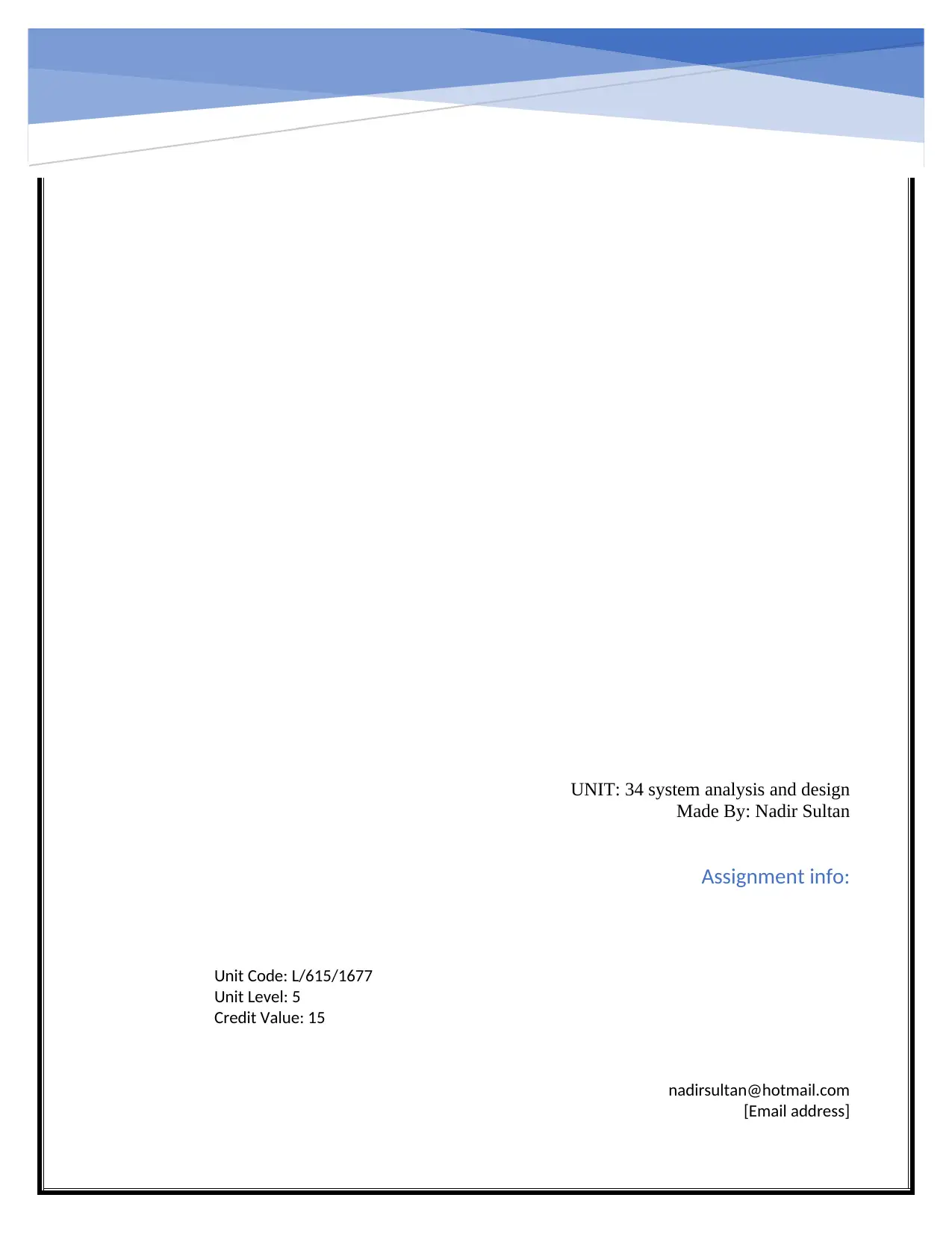
UNIT: 34 system analysis and design
Made By: Nadir Sultan
nadirsultan@hotmail.com
[Email address]
Assignment info:
Unit Code: L/615/1677
Unit Level: 5
Credit Value: 15
Made By: Nadir Sultan
nadirsultan@hotmail.com
[Email address]
Assignment info:
Unit Code: L/615/1677
Unit Level: 5
Credit Value: 15
Paraphrase This Document
Need a fresh take? Get an instant paraphrase of this document with our AI Paraphraser
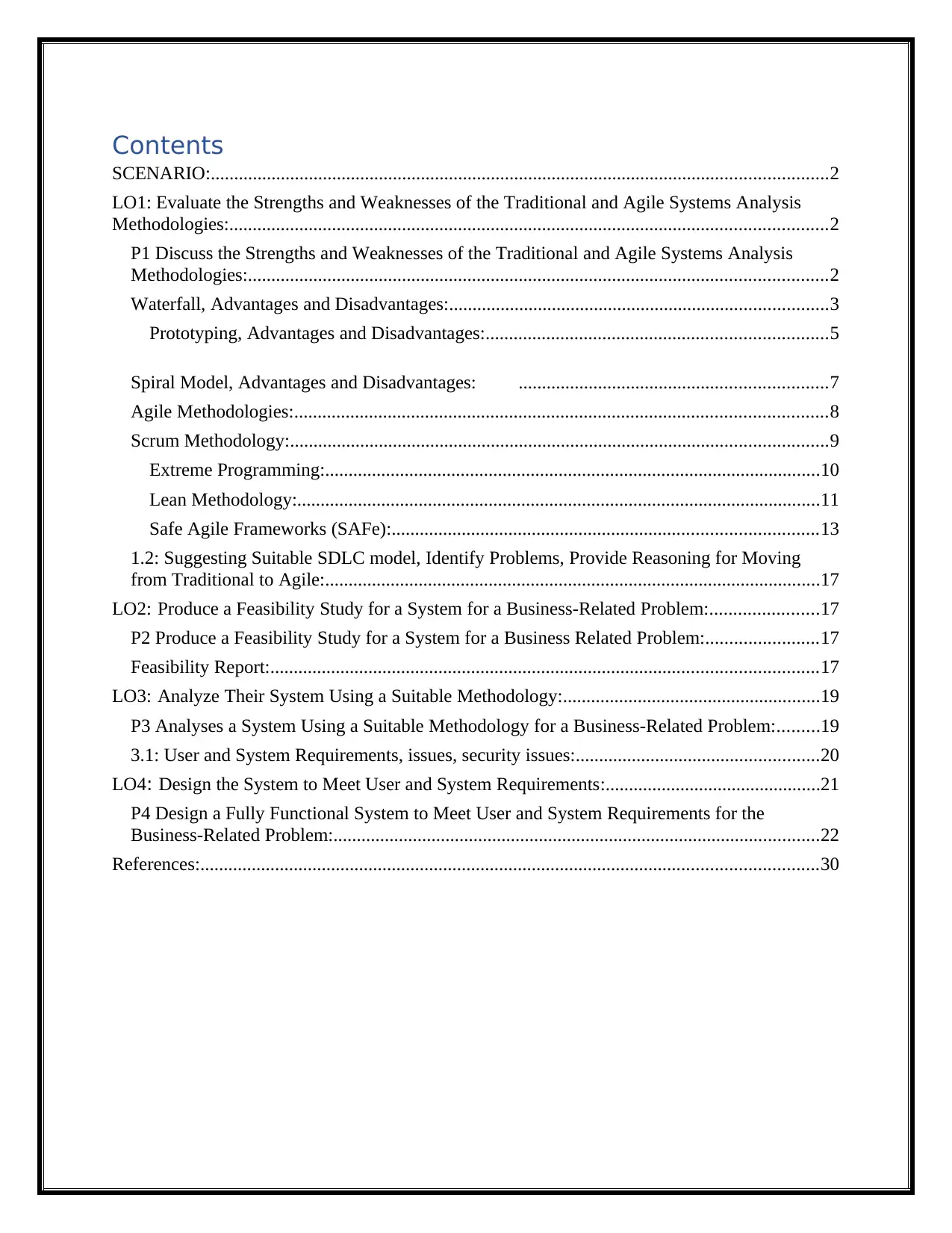
Contents
SCENARIO:....................................................................................................................................2
LO1: Evaluate the Strengths and Weaknesses of the Traditional and Agile Systems Analysis
Methodologies:................................................................................................................................2
P1 Discuss the Strengths and Weaknesses of the Traditional and Agile Systems Analysis
Methodologies:............................................................................................................................2
Waterfall, Advantages and Disadvantages:.................................................................................3
Prototyping, Advantages and Disadvantages:.........................................................................5
Spiral Model, Advantages and Disadvantages: ..................................................................7
Agile Methodologies:..................................................................................................................8
Scrum Methodology:...................................................................................................................9
Extreme Programming:..........................................................................................................10
Lean Methodology:................................................................................................................11
Safe Agile Frameworks (SAFe):...........................................................................................13
1.2: Suggesting Suitable SDLC model, Identify Problems, Provide Reasoning for Moving
from Traditional to Agile:..........................................................................................................17
LO2: Produce a Feasibility Study for a System for a Business-Related Problem:.......................17
P2 Produce a Feasibility Study for a System for a Business Related Problem:........................17
Feasibility Report:.....................................................................................................................17
LO3: Analyze Their System Using a Suitable Methodology:.......................................................19
P3 Analyses a System Using a Suitable Methodology for a Business-Related Problem:.........19
3.1: User and System Requirements, issues, security issues:....................................................20
LO4: Design the System to Meet User and System Requirements:..............................................21
P4 Design a Fully Functional System to Meet User and System Requirements for the
Business-Related Problem:........................................................................................................22
References:....................................................................................................................................30
SCENARIO:....................................................................................................................................2
LO1: Evaluate the Strengths and Weaknesses of the Traditional and Agile Systems Analysis
Methodologies:................................................................................................................................2
P1 Discuss the Strengths and Weaknesses of the Traditional and Agile Systems Analysis
Methodologies:............................................................................................................................2
Waterfall, Advantages and Disadvantages:.................................................................................3
Prototyping, Advantages and Disadvantages:.........................................................................5
Spiral Model, Advantages and Disadvantages: ..................................................................7
Agile Methodologies:..................................................................................................................8
Scrum Methodology:...................................................................................................................9
Extreme Programming:..........................................................................................................10
Lean Methodology:................................................................................................................11
Safe Agile Frameworks (SAFe):...........................................................................................13
1.2: Suggesting Suitable SDLC model, Identify Problems, Provide Reasoning for Moving
from Traditional to Agile:..........................................................................................................17
LO2: Produce a Feasibility Study for a System for a Business-Related Problem:.......................17
P2 Produce a Feasibility Study for a System for a Business Related Problem:........................17
Feasibility Report:.....................................................................................................................17
LO3: Analyze Their System Using a Suitable Methodology:.......................................................19
P3 Analyses a System Using a Suitable Methodology for a Business-Related Problem:.........19
3.1: User and System Requirements, issues, security issues:....................................................20
LO4: Design the System to Meet User and System Requirements:..............................................21
P4 Design a Fully Functional System to Meet User and System Requirements for the
Business-Related Problem:........................................................................................................22
References:....................................................................................................................................30
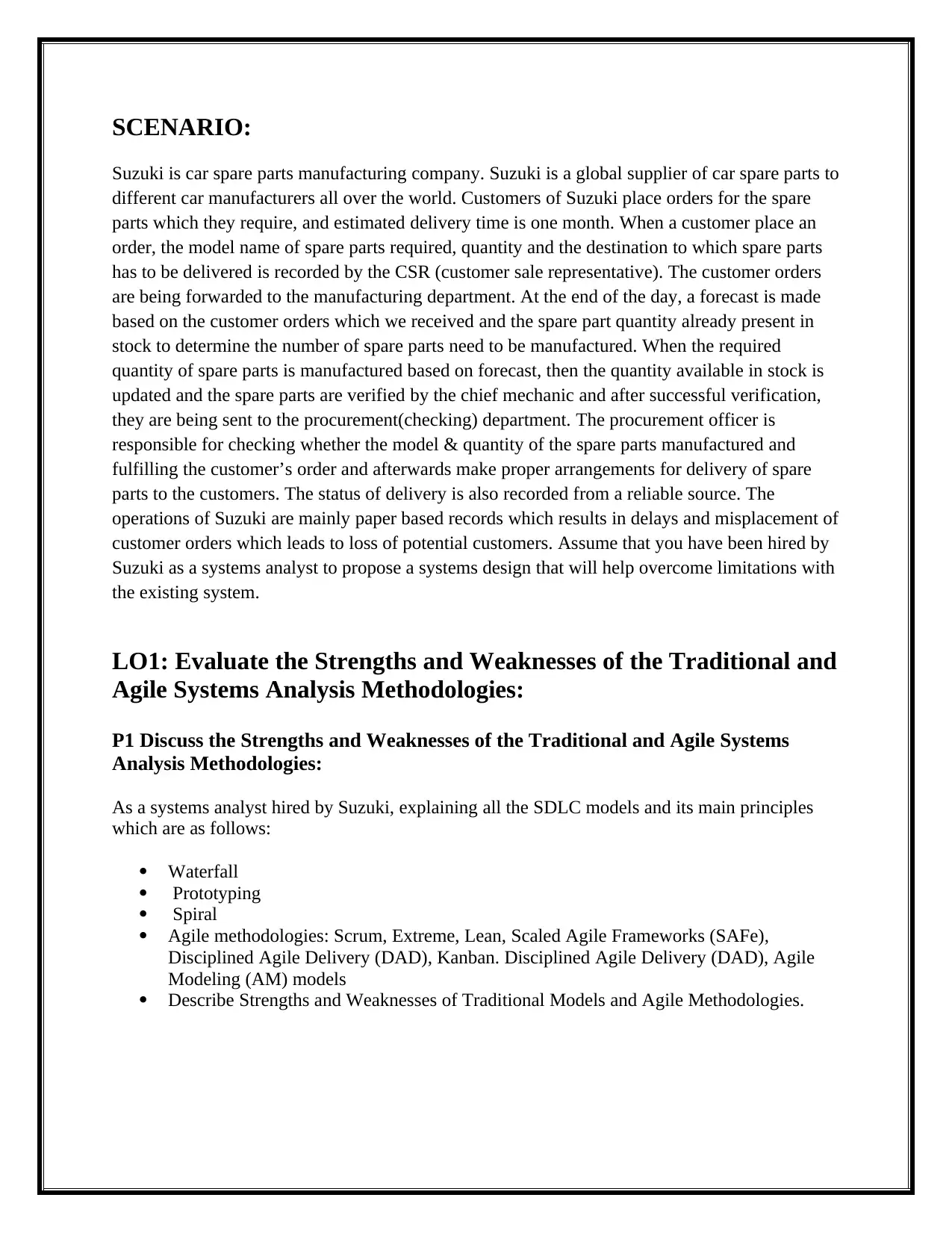
SCENARIO:
Suzuki is car spare parts manufacturing company. Suzuki is a global supplier of car spare parts to
different car manufacturers all over the world. Customers of Suzuki place orders for the spare
parts which they require, and estimated delivery time is one month. When a customer place an
order, the model name of spare parts required, quantity and the destination to which spare parts
has to be delivered is recorded by the CSR (customer sale representative). The customer orders
are being forwarded to the manufacturing department. At the end of the day, a forecast is made
based on the customer orders which we received and the spare part quantity already present in
stock to determine the number of spare parts need to be manufactured. When the required
quantity of spare parts is manufactured based on forecast, then the quantity available in stock is
updated and the spare parts are verified by the chief mechanic and after successful verification,
they are being sent to the procurement(checking) department. The procurement officer is
responsible for checking whether the model & quantity of the spare parts manufactured and
fulfilling the customer’s order and afterwards make proper arrangements for delivery of spare
parts to the customers. The status of delivery is also recorded from a reliable source. The
operations of Suzuki are mainly paper based records which results in delays and misplacement of
customer orders which leads to loss of potential customers. Assume that you have been hired by
Suzuki as a systems analyst to propose a systems design that will help overcome limitations with
the existing system.
LO1: Evaluate the Strengths and Weaknesses of the Traditional and
Agile Systems Analysis Methodologies:
P1 Discuss the Strengths and Weaknesses of the Traditional and Agile Systems
Analysis Methodologies:
As a systems analyst hired by Suzuki, explaining all the SDLC models and its main principles
which are as follows:
Waterfall
Prototyping
Spiral
Agile methodologies: Scrum, Extreme, Lean, Scaled Agile Frameworks (SAFe),
Disciplined Agile Delivery (DAD), Kanban. Disciplined Agile Delivery (DAD), Agile
Modeling (AM) models
Describe Strengths and Weaknesses of Traditional Models and Agile Methodologies.
Suzuki is car spare parts manufacturing company. Suzuki is a global supplier of car spare parts to
different car manufacturers all over the world. Customers of Suzuki place orders for the spare
parts which they require, and estimated delivery time is one month. When a customer place an
order, the model name of spare parts required, quantity and the destination to which spare parts
has to be delivered is recorded by the CSR (customer sale representative). The customer orders
are being forwarded to the manufacturing department. At the end of the day, a forecast is made
based on the customer orders which we received and the spare part quantity already present in
stock to determine the number of spare parts need to be manufactured. When the required
quantity of spare parts is manufactured based on forecast, then the quantity available in stock is
updated and the spare parts are verified by the chief mechanic and after successful verification,
they are being sent to the procurement(checking) department. The procurement officer is
responsible for checking whether the model & quantity of the spare parts manufactured and
fulfilling the customer’s order and afterwards make proper arrangements for delivery of spare
parts to the customers. The status of delivery is also recorded from a reliable source. The
operations of Suzuki are mainly paper based records which results in delays and misplacement of
customer orders which leads to loss of potential customers. Assume that you have been hired by
Suzuki as a systems analyst to propose a systems design that will help overcome limitations with
the existing system.
LO1: Evaluate the Strengths and Weaknesses of the Traditional and
Agile Systems Analysis Methodologies:
P1 Discuss the Strengths and Weaknesses of the Traditional and Agile Systems
Analysis Methodologies:
As a systems analyst hired by Suzuki, explaining all the SDLC models and its main principles
which are as follows:
Waterfall
Prototyping
Spiral
Agile methodologies: Scrum, Extreme, Lean, Scaled Agile Frameworks (SAFe),
Disciplined Agile Delivery (DAD), Kanban. Disciplined Agile Delivery (DAD), Agile
Modeling (AM) models
Describe Strengths and Weaknesses of Traditional Models and Agile Methodologies.
⊘ This is a preview!⊘
Do you want full access?
Subscribe today to unlock all pages.

Trusted by 1+ million students worldwide
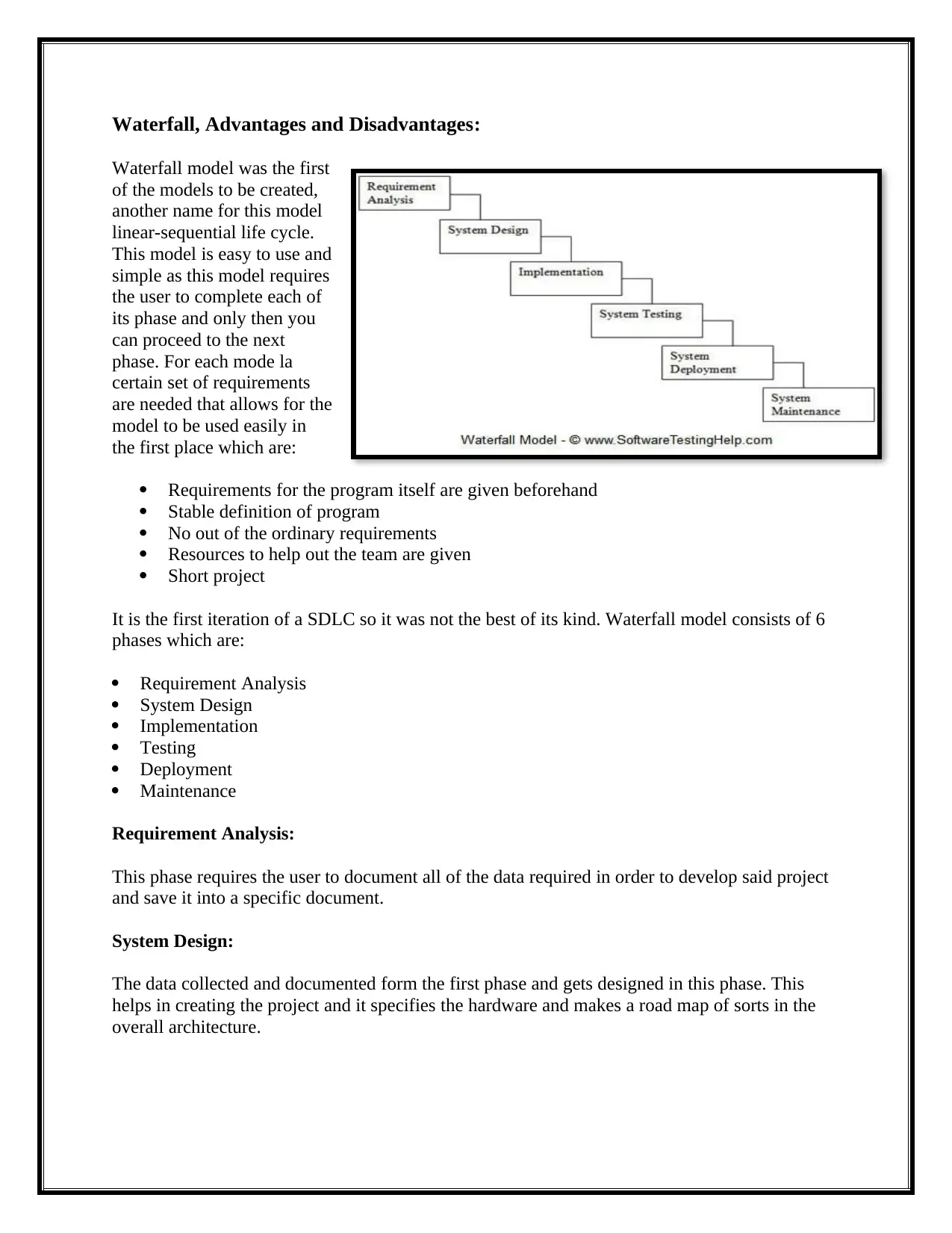
Waterfall, Advantages and Disadvantages:
Waterfall model was the first
of the models to be created,
another name for this model
linear-sequential life cycle.
This model is easy to use and
simple as this model requires
the user to complete each of
its phase and only then you
can proceed to the next
phase. For each mode la
certain set of requirements
are needed that allows for the
model to be used easily in
the first place which are:
Requirements for the program itself are given beforehand
Stable definition of program
No out of the ordinary requirements
Resources to help out the team are given
Short project
It is the first iteration of a SDLC so it was not the best of its kind. Waterfall model consists of 6
phases which are:
Requirement Analysis
System Design
Implementation
Testing
Deployment
Maintenance
Requirement Analysis:
This phase requires the user to document all of the data required in order to develop said project
and save it into a specific document.
System Design:
The data collected and documented form the first phase and gets designed in this phase. This
helps in creating the project and it specifies the hardware and makes a road map of sorts in the
overall architecture.
Waterfall model was the first
of the models to be created,
another name for this model
linear-sequential life cycle.
This model is easy to use and
simple as this model requires
the user to complete each of
its phase and only then you
can proceed to the next
phase. For each mode la
certain set of requirements
are needed that allows for the
model to be used easily in
the first place which are:
Requirements for the program itself are given beforehand
Stable definition of program
No out of the ordinary requirements
Resources to help out the team are given
Short project
It is the first iteration of a SDLC so it was not the best of its kind. Waterfall model consists of 6
phases which are:
Requirement Analysis
System Design
Implementation
Testing
Deployment
Maintenance
Requirement Analysis:
This phase requires the user to document all of the data required in order to develop said project
and save it into a specific document.
System Design:
The data collected and documented form the first phase and gets designed in this phase. This
helps in creating the project and it specifies the hardware and makes a road map of sorts in the
overall architecture.
Paraphrase This Document
Need a fresh take? Get an instant paraphrase of this document with our AI Paraphraser
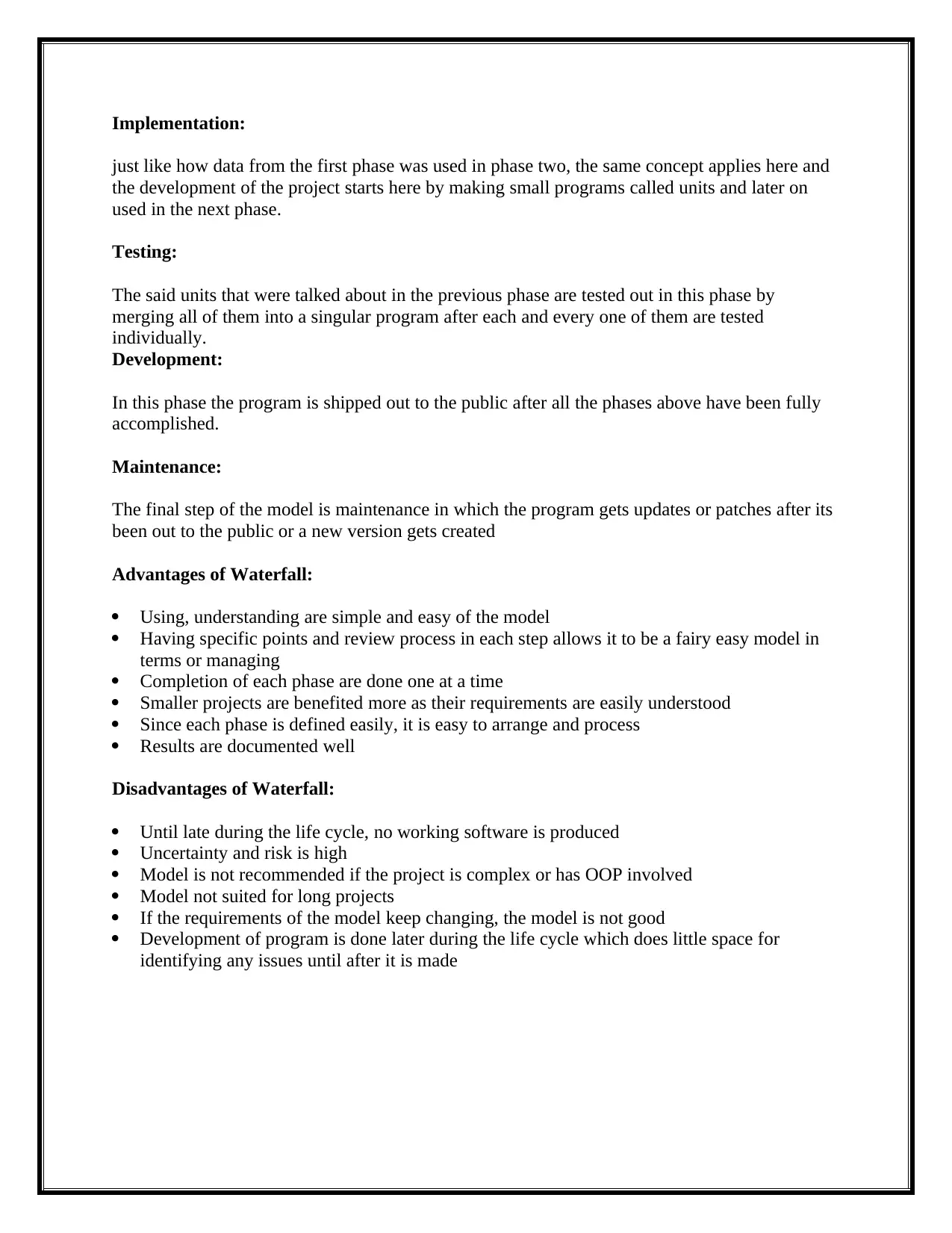
Implementation:
just like how data from the first phase was used in phase two, the same concept applies here and
the development of the project starts here by making small programs called units and later on
used in the next phase.
Testing:
The said units that were talked about in the previous phase are tested out in this phase by
merging all of them into a singular program after each and every one of them are tested
individually.
Development:
In this phase the program is shipped out to the public after all the phases above have been fully
accomplished.
Maintenance:
The final step of the model is maintenance in which the program gets updates or patches after its
been out to the public or a new version gets created
Advantages of Waterfall:
Using, understanding are simple and easy of the model
Having specific points and review process in each step allows it to be a fairy easy model in
terms or managing
Completion of each phase are done one at a time
Smaller projects are benefited more as their requirements are easily understood
Since each phase is defined easily, it is easy to arrange and process
Results are documented well
Disadvantages of Waterfall:
Until late during the life cycle, no working software is produced
Uncertainty and risk is high
Model is not recommended if the project is complex or has OOP involved
Model not suited for long projects
If the requirements of the model keep changing, the model is not good
Development of program is done later during the life cycle which does little space for
identifying any issues until after it is made
just like how data from the first phase was used in phase two, the same concept applies here and
the development of the project starts here by making small programs called units and later on
used in the next phase.
Testing:
The said units that were talked about in the previous phase are tested out in this phase by
merging all of them into a singular program after each and every one of them are tested
individually.
Development:
In this phase the program is shipped out to the public after all the phases above have been fully
accomplished.
Maintenance:
The final step of the model is maintenance in which the program gets updates or patches after its
been out to the public or a new version gets created
Advantages of Waterfall:
Using, understanding are simple and easy of the model
Having specific points and review process in each step allows it to be a fairy easy model in
terms or managing
Completion of each phase are done one at a time
Smaller projects are benefited more as their requirements are easily understood
Since each phase is defined easily, it is easy to arrange and process
Results are documented well
Disadvantages of Waterfall:
Until late during the life cycle, no working software is produced
Uncertainty and risk is high
Model is not recommended if the project is complex or has OOP involved
Model not suited for long projects
If the requirements of the model keep changing, the model is not good
Development of program is done later during the life cycle which does little space for
identifying any issues until after it is made
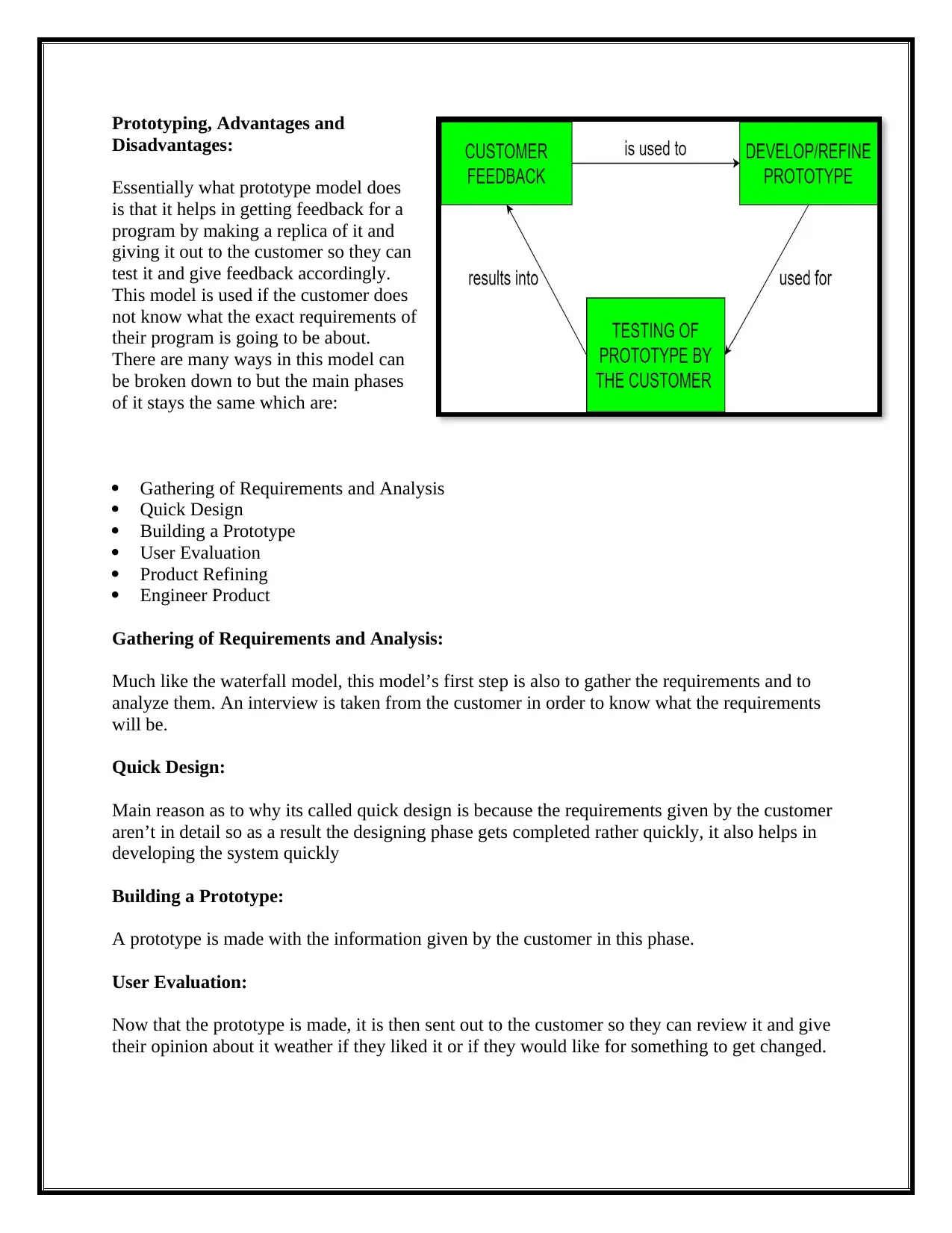
Prototyping, Advantages and
Disadvantages:
Essentially what prototype model does
is that it helps in getting feedback for a
program by making a replica of it and
giving it out to the customer so they can
test it and give feedback accordingly.
This model is used if the customer does
not know what the exact requirements of
their program is going to be about.
There are many ways in this model can
be broken down to but the main phases
of it stays the same which are:
Gathering of Requirements and Analysis
Quick Design
Building a Prototype
User Evaluation
Product Refining
Engineer Product
Gathering of Requirements and Analysis:
Much like the waterfall model, this model’s first step is also to gather the requirements and to
analyze them. An interview is taken from the customer in order to know what the requirements
will be.
Quick Design:
Main reason as to why its called quick design is because the requirements given by the customer
aren’t in detail so as a result the designing phase gets completed rather quickly, it also helps in
developing the system quickly
Building a Prototype:
A prototype is made with the information given by the customer in this phase.
User Evaluation:
Now that the prototype is made, it is then sent out to the customer so they can review it and give
their opinion about it weather if they liked it or if they would like for something to get changed.
Disadvantages:
Essentially what prototype model does
is that it helps in getting feedback for a
program by making a replica of it and
giving it out to the customer so they can
test it and give feedback accordingly.
This model is used if the customer does
not know what the exact requirements of
their program is going to be about.
There are many ways in this model can
be broken down to but the main phases
of it stays the same which are:
Gathering of Requirements and Analysis
Quick Design
Building a Prototype
User Evaluation
Product Refining
Engineer Product
Gathering of Requirements and Analysis:
Much like the waterfall model, this model’s first step is also to gather the requirements and to
analyze them. An interview is taken from the customer in order to know what the requirements
will be.
Quick Design:
Main reason as to why its called quick design is because the requirements given by the customer
aren’t in detail so as a result the designing phase gets completed rather quickly, it also helps in
developing the system quickly
Building a Prototype:
A prototype is made with the information given by the customer in this phase.
User Evaluation:
Now that the prototype is made, it is then sent out to the customer so they can review it and give
their opinion about it weather if they liked it or if they would like for something to get changed.
⊘ This is a preview!⊘
Do you want full access?
Subscribe today to unlock all pages.

Trusted by 1+ million students worldwide
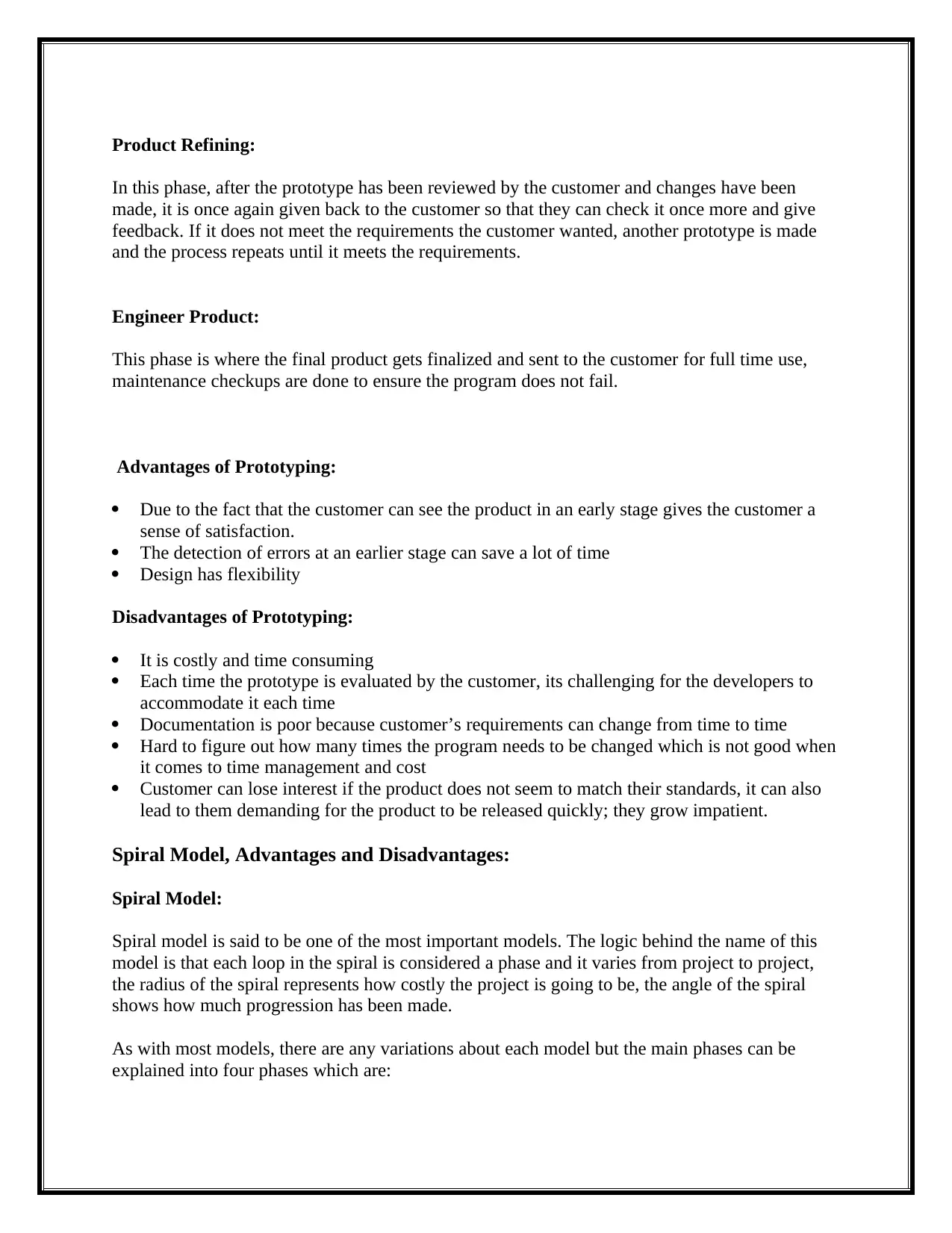
Product Refining:
In this phase, after the prototype has been reviewed by the customer and changes have been
made, it is once again given back to the customer so that they can check it once more and give
feedback. If it does not meet the requirements the customer wanted, another prototype is made
and the process repeats until it meets the requirements.
Engineer Product:
This phase is where the final product gets finalized and sent to the customer for full time use,
maintenance checkups are done to ensure the program does not fail.
Advantages of Prototyping:
Due to the fact that the customer can see the product in an early stage gives the customer a
sense of satisfaction.
The detection of errors at an earlier stage can save a lot of time
Design has flexibility
Disadvantages of Prototyping:
It is costly and time consuming
Each time the prototype is evaluated by the customer, its challenging for the developers to
accommodate it each time
Documentation is poor because customer’s requirements can change from time to time
Hard to figure out how many times the program needs to be changed which is not good when
it comes to time management and cost
Customer can lose interest if the product does not seem to match their standards, it can also
lead to them demanding for the product to be released quickly; they grow impatient.
Spiral Model, Advantages and Disadvantages:
Spiral Model:
Spiral model is said to be one of the most important models. The logic behind the name of this
model is that each loop in the spiral is considered a phase and it varies from project to project,
the radius of the spiral represents how costly the project is going to be, the angle of the spiral
shows how much progression has been made.
As with most models, there are any variations about each model but the main phases can be
explained into four phases which are:
In this phase, after the prototype has been reviewed by the customer and changes have been
made, it is once again given back to the customer so that they can check it once more and give
feedback. If it does not meet the requirements the customer wanted, another prototype is made
and the process repeats until it meets the requirements.
Engineer Product:
This phase is where the final product gets finalized and sent to the customer for full time use,
maintenance checkups are done to ensure the program does not fail.
Advantages of Prototyping:
Due to the fact that the customer can see the product in an early stage gives the customer a
sense of satisfaction.
The detection of errors at an earlier stage can save a lot of time
Design has flexibility
Disadvantages of Prototyping:
It is costly and time consuming
Each time the prototype is evaluated by the customer, its challenging for the developers to
accommodate it each time
Documentation is poor because customer’s requirements can change from time to time
Hard to figure out how many times the program needs to be changed which is not good when
it comes to time management and cost
Customer can lose interest if the product does not seem to match their standards, it can also
lead to them demanding for the product to be released quickly; they grow impatient.
Spiral Model, Advantages and Disadvantages:
Spiral Model:
Spiral model is said to be one of the most important models. The logic behind the name of this
model is that each loop in the spiral is considered a phase and it varies from project to project,
the radius of the spiral represents how costly the project is going to be, the angle of the spiral
shows how much progression has been made.
As with most models, there are any variations about each model but the main phases can be
explained into four phases which are:
Paraphrase This Document
Need a fresh take? Get an instant paraphrase of this document with our AI Paraphraser
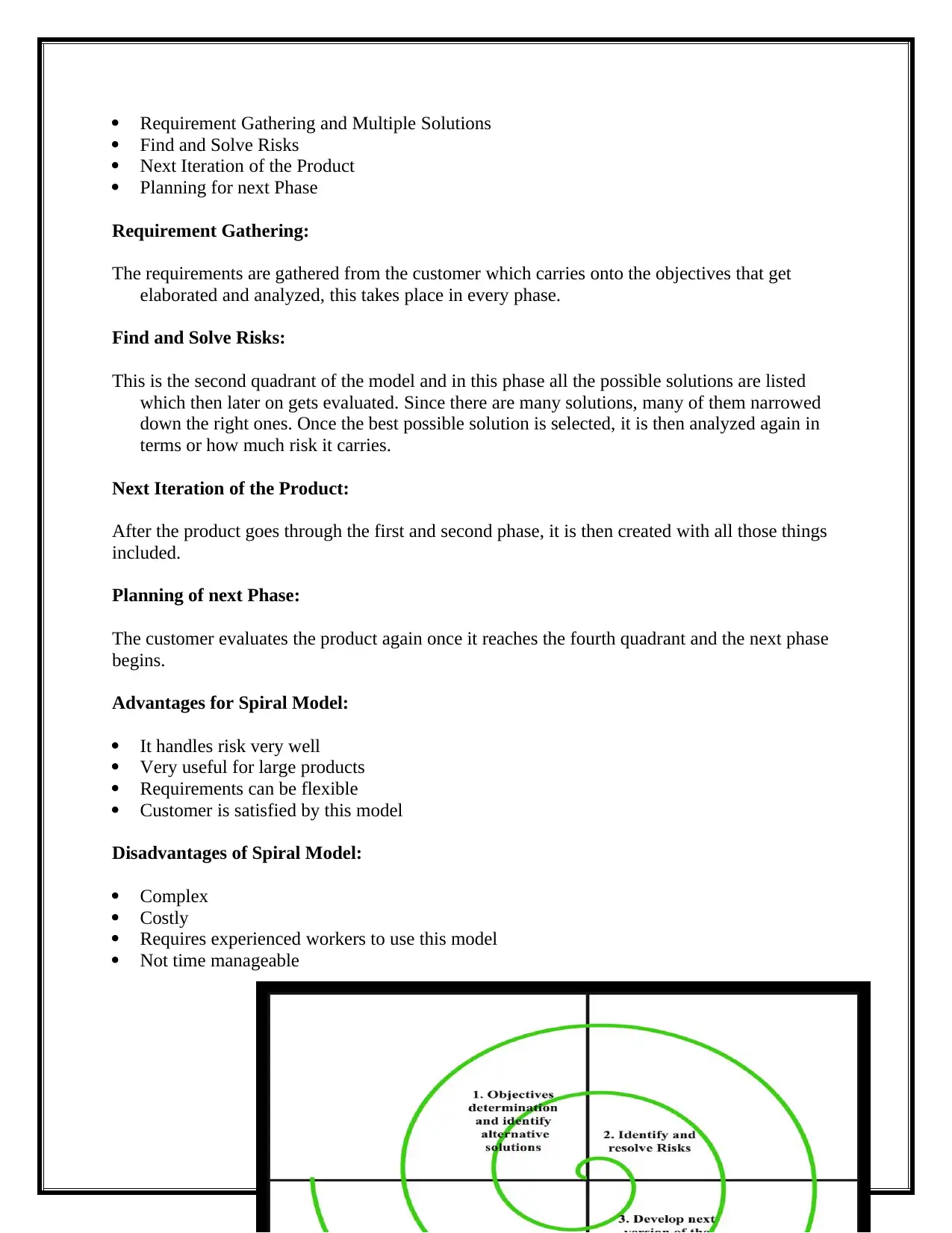
Requirement Gathering and Multiple Solutions
Find and Solve Risks
Next Iteration of the Product
Planning for next Phase
Requirement Gathering:
The requirements are gathered from the customer which carries onto the objectives that get
elaborated and analyzed, this takes place in every phase.
Find and Solve Risks:
This is the second quadrant of the model and in this phase all the possible solutions are listed
which then later on gets evaluated. Since there are many solutions, many of them narrowed
down the right ones. Once the best possible solution is selected, it is then analyzed again in
terms or how much risk it carries.
Next Iteration of the Product:
After the product goes through the first and second phase, it is then created with all those things
included.
Planning of next Phase:
The customer evaluates the product again once it reaches the fourth quadrant and the next phase
begins.
Advantages for Spiral Model:
It handles risk very well
Very useful for large products
Requirements can be flexible
Customer is satisfied by this model
Disadvantages of Spiral Model:
Complex
Costly
Requires experienced workers to use this model
Not time manageable
Find and Solve Risks
Next Iteration of the Product
Planning for next Phase
Requirement Gathering:
The requirements are gathered from the customer which carries onto the objectives that get
elaborated and analyzed, this takes place in every phase.
Find and Solve Risks:
This is the second quadrant of the model and in this phase all the possible solutions are listed
which then later on gets evaluated. Since there are many solutions, many of them narrowed
down the right ones. Once the best possible solution is selected, it is then analyzed again in
terms or how much risk it carries.
Next Iteration of the Product:
After the product goes through the first and second phase, it is then created with all those things
included.
Planning of next Phase:
The customer evaluates the product again once it reaches the fourth quadrant and the next phase
begins.
Advantages for Spiral Model:
It handles risk very well
Very useful for large products
Requirements can be flexible
Customer is satisfied by this model
Disadvantages of Spiral Model:
Complex
Costly
Requires experienced workers to use this model
Not time manageable
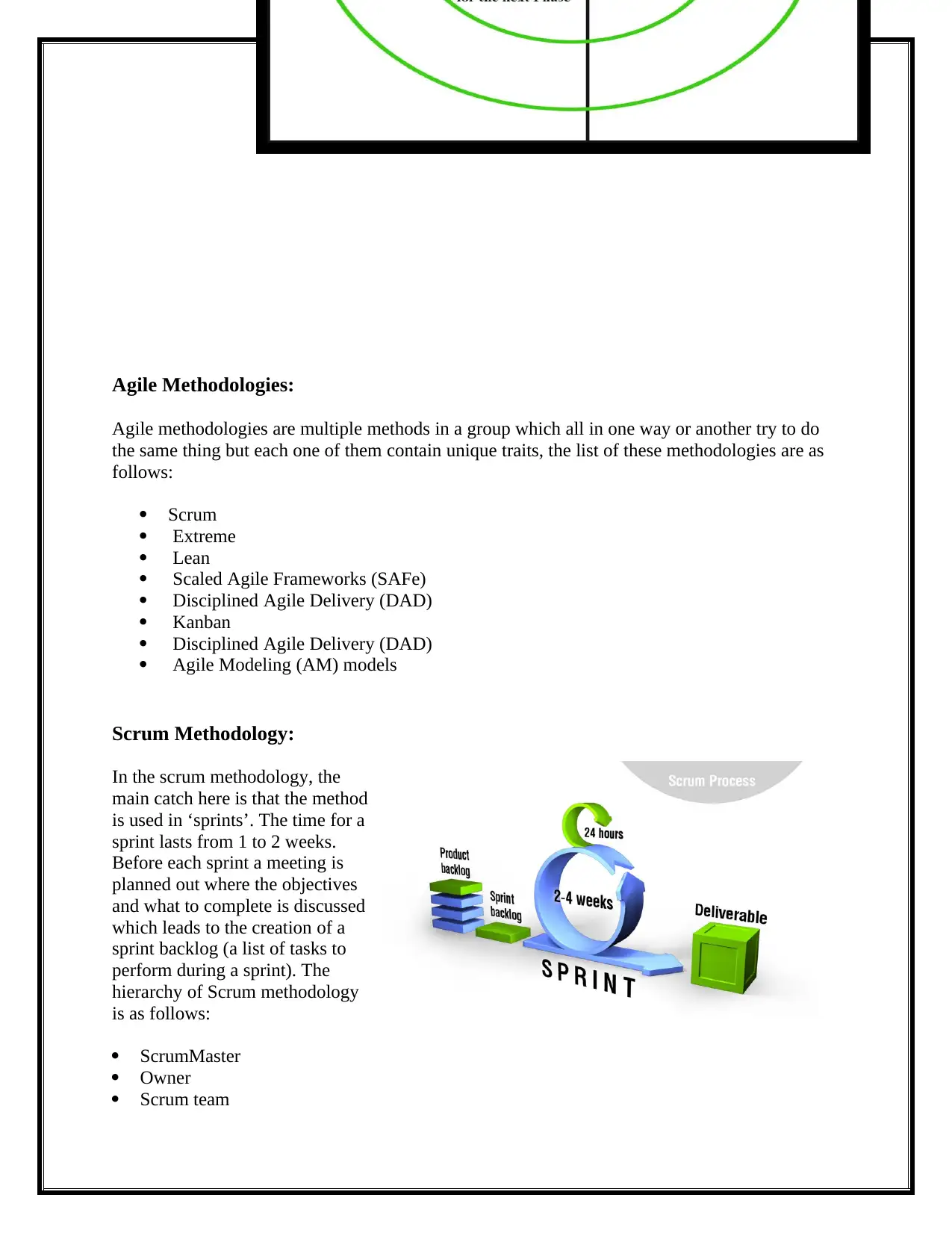
Agile Methodologies:
Agile methodologies are multiple methods in a group which all in one way or another try to do
the same thing but each one of them contain unique traits, the list of these methodologies are as
follows:
Scrum
Extreme
Lean
Scaled Agile Frameworks (SAFe)
Disciplined Agile Delivery (DAD)
Kanban
Disciplined Agile Delivery (DAD)
Agile Modeling (AM) models
Scrum Methodology:
In the scrum methodology, the
main catch here is that the method
is used in ‘sprints’. The time for a
sprint lasts from 1 to 2 weeks.
Before each sprint a meeting is
planned out where the objectives
and what to complete is discussed
which leads to the creation of a
sprint backlog (a list of tasks to
perform during a sprint). The
hierarchy of Scrum methodology
is as follows:
ScrumMaster
Owner
Scrum team
Agile methodologies are multiple methods in a group which all in one way or another try to do
the same thing but each one of them contain unique traits, the list of these methodologies are as
follows:
Scrum
Extreme
Lean
Scaled Agile Frameworks (SAFe)
Disciplined Agile Delivery (DAD)
Kanban
Disciplined Agile Delivery (DAD)
Agile Modeling (AM) models
Scrum Methodology:
In the scrum methodology, the
main catch here is that the method
is used in ‘sprints’. The time for a
sprint lasts from 1 to 2 weeks.
Before each sprint a meeting is
planned out where the objectives
and what to complete is discussed
which leads to the creation of a
sprint backlog (a list of tasks to
perform during a sprint). The
hierarchy of Scrum methodology
is as follows:
ScrumMaster
Owner
Scrum team
⊘ This is a preview!⊘
Do you want full access?
Subscribe today to unlock all pages.

Trusted by 1+ million students worldwide
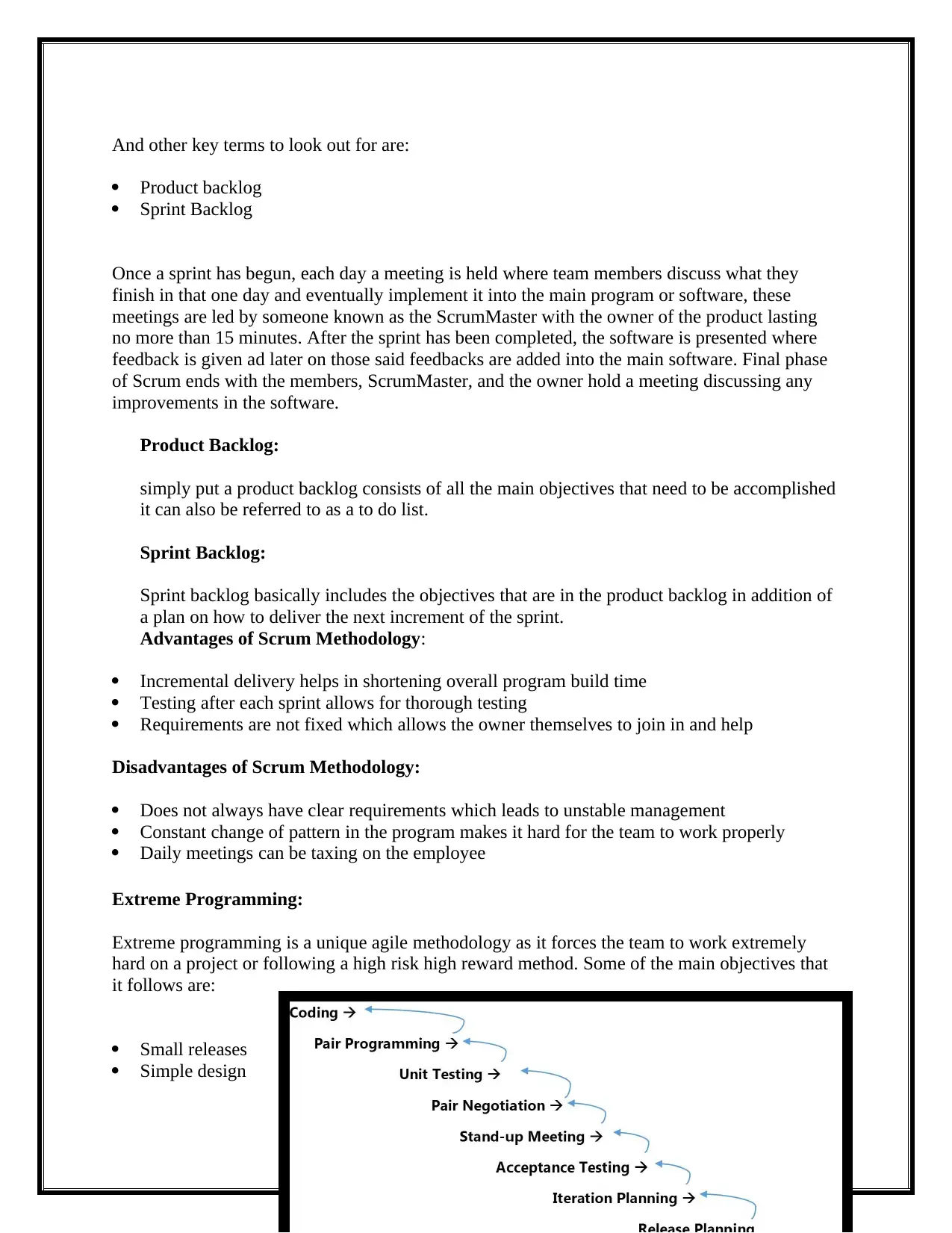
And other key terms to look out for are:
Product backlog
Sprint Backlog
Once a sprint has begun, each day a meeting is held where team members discuss what they
finish in that one day and eventually implement it into the main program or software, these
meetings are led by someone known as the ScrumMaster with the owner of the product lasting
no more than 15 minutes. After the sprint has been completed, the software is presented where
feedback is given ad later on those said feedbacks are added into the main software. Final phase
of Scrum ends with the members, ScrumMaster, and the owner hold a meeting discussing any
improvements in the software.
Product Backlog:
simply put a product backlog consists of all the main objectives that need to be accomplished
it can also be referred to as a to do list.
Sprint Backlog:
Sprint backlog basically includes the objectives that are in the product backlog in addition of
a plan on how to deliver the next increment of the sprint.
Advantages of Scrum Methodology:
Incremental delivery helps in shortening overall program build time
Testing after each sprint allows for thorough testing
Requirements are not fixed which allows the owner themselves to join in and help
Disadvantages of Scrum Methodology:
Does not always have clear requirements which leads to unstable management
Constant change of pattern in the program makes it hard for the team to work properly
Daily meetings can be taxing on the employee
Extreme Programming:
Extreme programming is a unique agile methodology as it forces the team to work extremely
hard on a project or following a high risk high reward method. Some of the main objectives that
it follows are:
Small releases
Simple design
Product backlog
Sprint Backlog
Once a sprint has begun, each day a meeting is held where team members discuss what they
finish in that one day and eventually implement it into the main program or software, these
meetings are led by someone known as the ScrumMaster with the owner of the product lasting
no more than 15 minutes. After the sprint has been completed, the software is presented where
feedback is given ad later on those said feedbacks are added into the main software. Final phase
of Scrum ends with the members, ScrumMaster, and the owner hold a meeting discussing any
improvements in the software.
Product Backlog:
simply put a product backlog consists of all the main objectives that need to be accomplished
it can also be referred to as a to do list.
Sprint Backlog:
Sprint backlog basically includes the objectives that are in the product backlog in addition of
a plan on how to deliver the next increment of the sprint.
Advantages of Scrum Methodology:
Incremental delivery helps in shortening overall program build time
Testing after each sprint allows for thorough testing
Requirements are not fixed which allows the owner themselves to join in and help
Disadvantages of Scrum Methodology:
Does not always have clear requirements which leads to unstable management
Constant change of pattern in the program makes it hard for the team to work properly
Daily meetings can be taxing on the employee
Extreme Programming:
Extreme programming is a unique agile methodology as it forces the team to work extremely
hard on a project or following a high risk high reward method. Some of the main objectives that
it follows are:
Small releases
Simple design
Paraphrase This Document
Need a fresh take? Get an instant paraphrase of this document with our AI Paraphraser
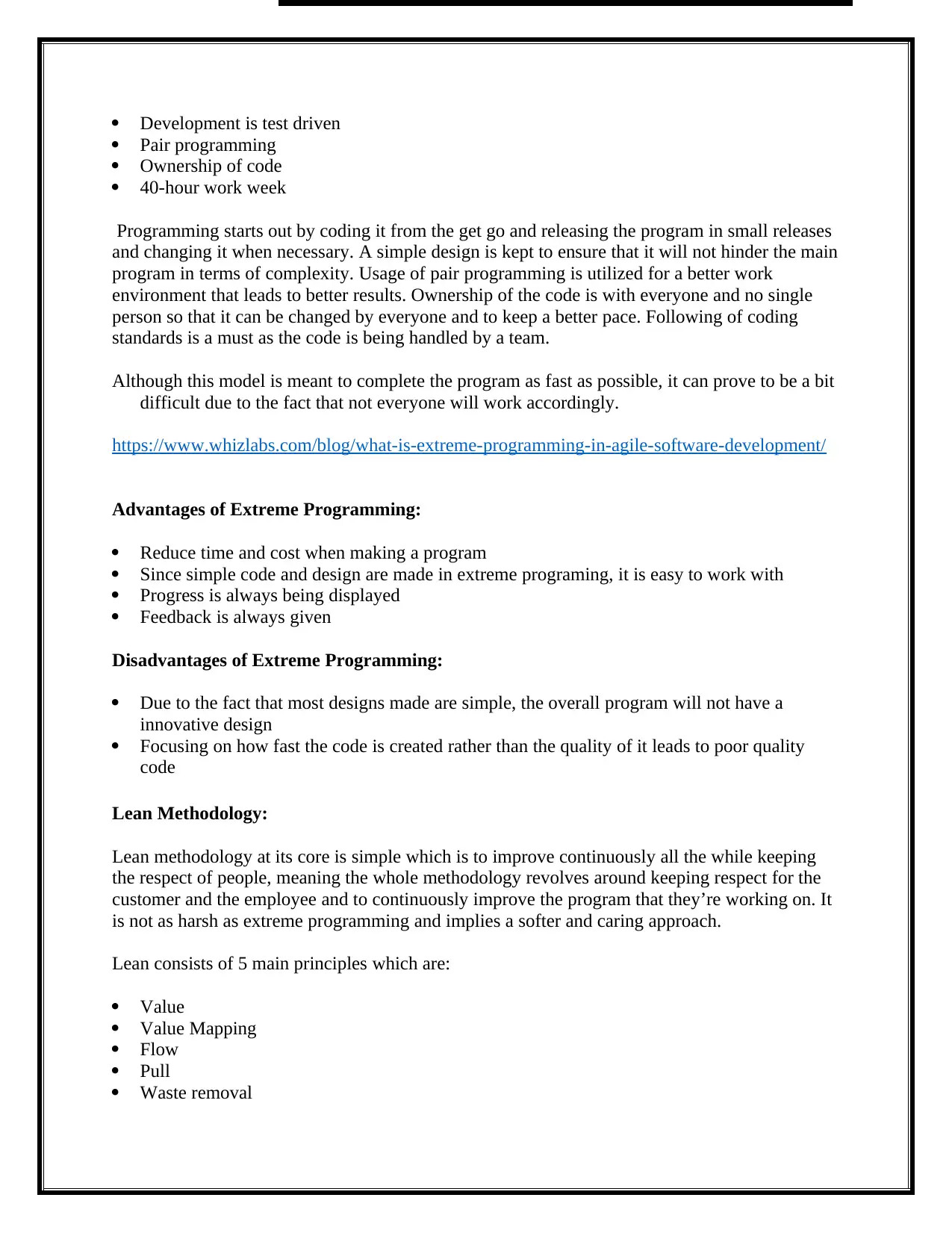
Development is test driven
Pair programming
Ownership of code
40-hour work week
Programming starts out by coding it from the get go and releasing the program in small releases
and changing it when necessary. A simple design is kept to ensure that it will not hinder the main
program in terms of complexity. Usage of pair programming is utilized for a better work
environment that leads to better results. Ownership of the code is with everyone and no single
person so that it can be changed by everyone and to keep a better pace. Following of coding
standards is a must as the code is being handled by a team.
Although this model is meant to complete the program as fast as possible, it can prove to be a bit
difficult due to the fact that not everyone will work accordingly.
https://www.whizlabs.com/blog/what-is-extreme-programming-in-agile-software-development/
Advantages of Extreme Programming:
Reduce time and cost when making a program
Since simple code and design are made in extreme programing, it is easy to work with
Progress is always being displayed
Feedback is always given
Disadvantages of Extreme Programming:
Due to the fact that most designs made are simple, the overall program will not have a
innovative design
Focusing on how fast the code is created rather than the quality of it leads to poor quality
code
Lean Methodology:
Lean methodology at its core is simple which is to improve continuously all the while keeping
the respect of people, meaning the whole methodology revolves around keeping respect for the
customer and the employee and to continuously improve the program that they’re working on. It
is not as harsh as extreme programming and implies a softer and caring approach.
Lean consists of 5 main principles which are:
Value
Value Mapping
Flow
Pull
Waste removal
Pair programming
Ownership of code
40-hour work week
Programming starts out by coding it from the get go and releasing the program in small releases
and changing it when necessary. A simple design is kept to ensure that it will not hinder the main
program in terms of complexity. Usage of pair programming is utilized for a better work
environment that leads to better results. Ownership of the code is with everyone and no single
person so that it can be changed by everyone and to keep a better pace. Following of coding
standards is a must as the code is being handled by a team.
Although this model is meant to complete the program as fast as possible, it can prove to be a bit
difficult due to the fact that not everyone will work accordingly.
https://www.whizlabs.com/blog/what-is-extreme-programming-in-agile-software-development/
Advantages of Extreme Programming:
Reduce time and cost when making a program
Since simple code and design are made in extreme programing, it is easy to work with
Progress is always being displayed
Feedback is always given
Disadvantages of Extreme Programming:
Due to the fact that most designs made are simple, the overall program will not have a
innovative design
Focusing on how fast the code is created rather than the quality of it leads to poor quality
code
Lean Methodology:
Lean methodology at its core is simple which is to improve continuously all the while keeping
the respect of people, meaning the whole methodology revolves around keeping respect for the
customer and the employee and to continuously improve the program that they’re working on. It
is not as harsh as extreme programming and implies a softer and caring approach.
Lean consists of 5 main principles which are:
Value
Value Mapping
Flow
Pull
Waste removal
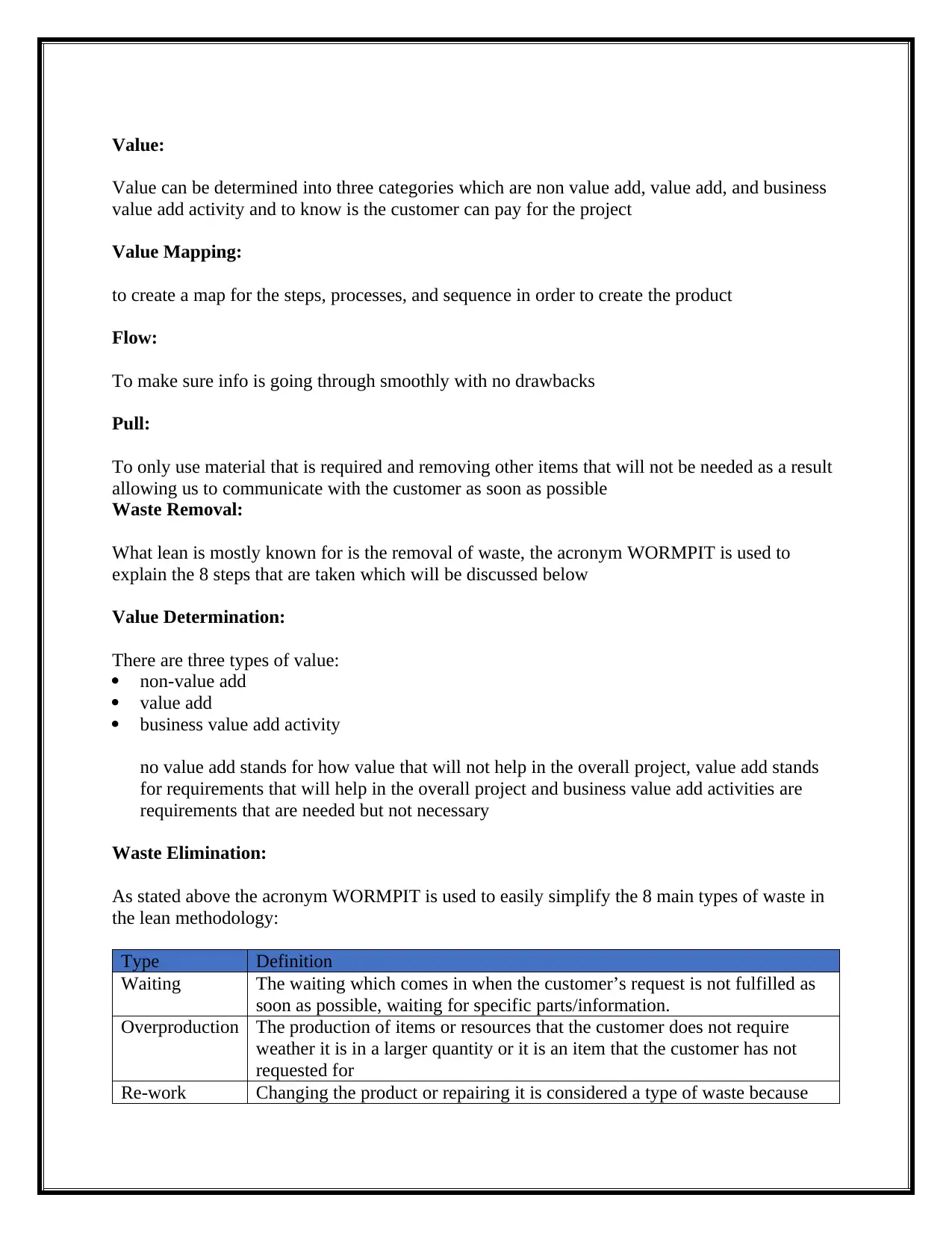
Value:
Value can be determined into three categories which are non value add, value add, and business
value add activity and to know is the customer can pay for the project
Value Mapping:
to create a map for the steps, processes, and sequence in order to create the product
Flow:
To make sure info is going through smoothly with no drawbacks
Pull:
To only use material that is required and removing other items that will not be needed as a result
allowing us to communicate with the customer as soon as possible
Waste Removal:
What lean is mostly known for is the removal of waste, the acronym WORMPIT is used to
explain the 8 steps that are taken which will be discussed below
Value Determination:
There are three types of value:
non-value add
value add
business value add activity
no value add stands for how value that will not help in the overall project, value add stands
for requirements that will help in the overall project and business value add activities are
requirements that are needed but not necessary
Waste Elimination:
As stated above the acronym WORMPIT is used to easily simplify the 8 main types of waste in
the lean methodology:
Type Definition
Waiting The waiting which comes in when the customer’s request is not fulfilled as
soon as possible, waiting for specific parts/information.
Overproduction The production of items or resources that the customer does not require
weather it is in a larger quantity or it is an item that the customer has not
requested for
Re-work Changing the product or repairing it is considered a type of waste because
Value can be determined into three categories which are non value add, value add, and business
value add activity and to know is the customer can pay for the project
Value Mapping:
to create a map for the steps, processes, and sequence in order to create the product
Flow:
To make sure info is going through smoothly with no drawbacks
Pull:
To only use material that is required and removing other items that will not be needed as a result
allowing us to communicate with the customer as soon as possible
Waste Removal:
What lean is mostly known for is the removal of waste, the acronym WORMPIT is used to
explain the 8 steps that are taken which will be discussed below
Value Determination:
There are three types of value:
non-value add
value add
business value add activity
no value add stands for how value that will not help in the overall project, value add stands
for requirements that will help in the overall project and business value add activities are
requirements that are needed but not necessary
Waste Elimination:
As stated above the acronym WORMPIT is used to easily simplify the 8 main types of waste in
the lean methodology:
Type Definition
Waiting The waiting which comes in when the customer’s request is not fulfilled as
soon as possible, waiting for specific parts/information.
Overproduction The production of items or resources that the customer does not require
weather it is in a larger quantity or it is an item that the customer has not
requested for
Re-work Changing the product or repairing it is considered a type of waste because
⊘ This is a preview!⊘
Do you want full access?
Subscribe today to unlock all pages.

Trusted by 1+ million students worldwide
1 out of 30
Your All-in-One AI-Powered Toolkit for Academic Success.
+13062052269
info@desklib.com
Available 24*7 on WhatsApp / Email
![[object Object]](/_next/static/media/star-bottom.7253800d.svg)
Unlock your academic potential
Copyright © 2020–2025 A2Z Services. All Rights Reserved. Developed and managed by ZUCOL.
